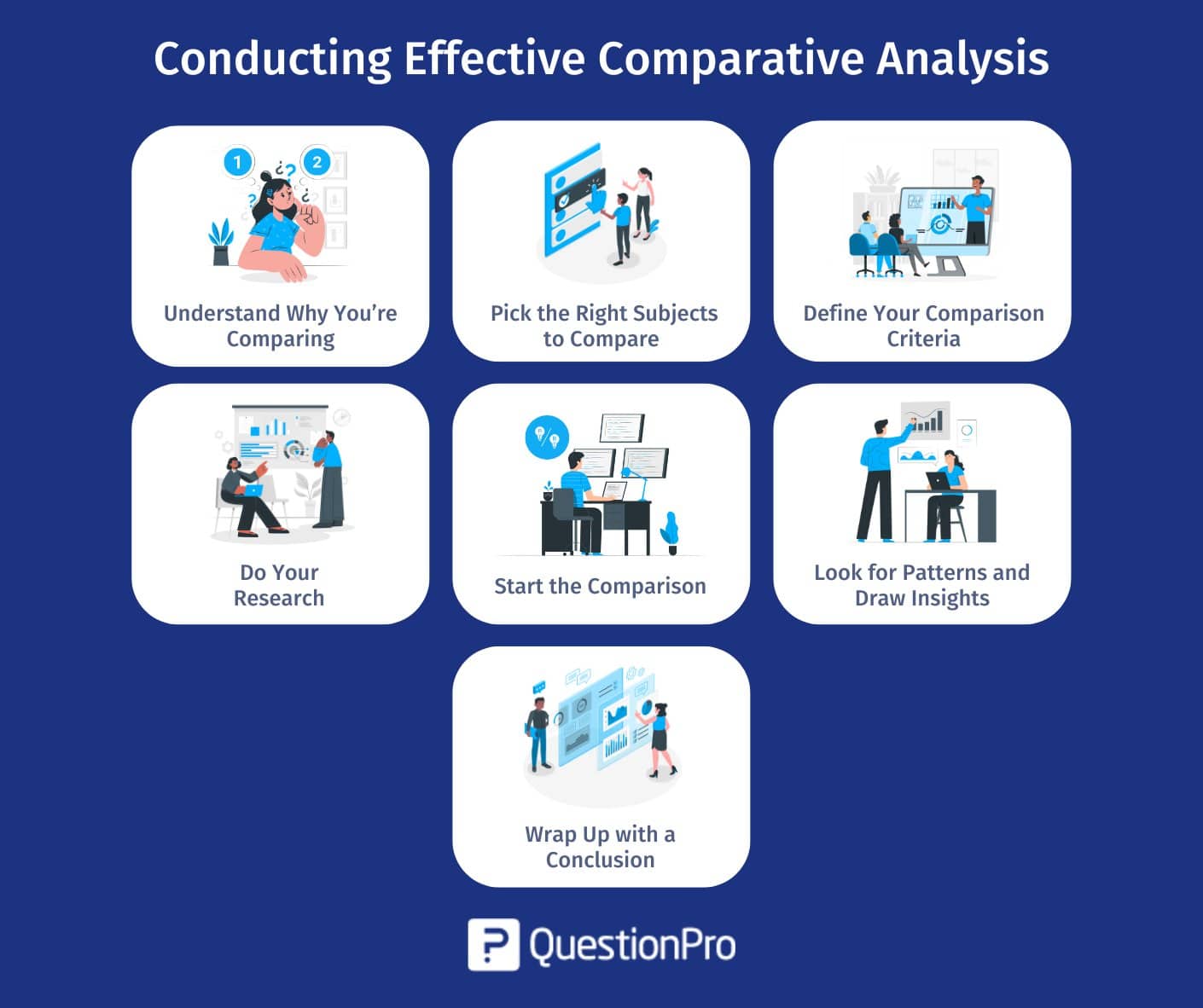
When a business wants to start a marketing campaign or grow, a comparative analysis can give them information that helps them make crucial decisions.
This analysis gathers different data sets to compare different options so a business can make good decisions for its customers and itself. If you or your business want to make good decisions, learning about comparative analyses could be helpful.
In this article, we’ll explain the comparative analysis and its importance so that you can make the most of this helpful methodology.
What is Comparative Analysis?
Comparative analysis is a way to look at two or more similar things to see how they are different and what they have in common.
It is used in many ways and fields to help people understand the similarities and differences between products better. It can help businesses make good decisions about key issues.
One meaningful way it’s used is when applied to scientific data. Scientific data is information that has been gathered through scientific research and will be used for a particular purpose.
When it is used on scientific data, it determines how consistent and reliable the data is. It also helps scientists make sure their data is accurate and valid.
Importance of Comparative Analysis
Comparative analyses are important if you want to understand a problem better or find answers to essential questions. Here are the main goals businesses want to reach through comparative analysis.
- It is a part of the diagnostic phase of business analytics. It can answer many of the most important questions a company may have and help you figure out how to fix problems at the company’s core to improve performance and even make more money.
- It encourages a deep understanding of the opportunities that apply to specific processes, departments, or business units. This analysis also ensures that we’re addressing the real reasons for performance gaps.
- It is used a lot because it helps people understand the challenges an organization has faced in the past and the ones it faces now. This method gives objective, fact-based information about performance and ways to improve it.
When to use a Comparative Analysis?
You use comparative analysis when you need to make a decision or understand something better by looking at two or more things closely. It helps when you want to compare different options, ideas, or situations to see how they stack up against each other.
Here are a few situations where it’s helpful:
- Choosing between options: If you’re deciding between two job offers, you might compare salary, location, and benefits.
- Evaluating performance: If you’re looking at two companies, brands, or products, a comparative analysis helps you see which one performs better.
- Problem-solving: If you’re trying to find the best solution, comparing different methods or approaches can help.
- Learning or understanding: When you want to understand how two things work differently, like comparing historical events, theories, or even movies.
In short, it’s a great tool to help you make clearer, more informed choices when you have multiple options or when you want to dig deeper into something.
How to Conduct an Effective Comparative Analysis?
Consider using the advice below to carry out a successful comparative analysis:

1. Understand Why You’re Comparing in the First Place
Before jumping into your analysis, you need to know why you’re comparing in the first place. Knowing the purpose of your comparison will help you stay focused.
For example, ask yourself:
- What’s the decision I’m trying to make?
- What’s important to me in this choice?
2. Pick the Right Subjects to Compare
Once you know your goal, it’s time to decide what you’re comparing. Whether it’s two products, two companies, or two ideas, make sure they’re comparable. If you’re comparing a luxury car with an economy model, it might not make sense to evaluate them on the same criteria.
It’s also helpful to narrow down your focus to what really matters. Are you comparing the features, costs, effectiveness, or something else?
3. Define Your Comparison Criteria
Now, it’s time to break things down. What specific features, aspects, or qualities will you focus on? If you’re comparing two smartphones, you might look at:
- Price
- Camera quality
- Battery life
- Ease of use
- Design
It’s about picking the factors that matter most to your decision. Once you’ve chosen your criteria, you’ll know exactly what to focus on during your comparison.
4. Do Your Research
Next, gather all the information you need. This part might feel like homework, but trust me, it’s worth it! Look for credible sources like expert reviews, customer feedback, and other relevant data.
5. Start the Comparison
Here’s where the magic happens. Now that you have your data compare the two subjects side by side. If you’re comparing two products, set it up like this:
Product A vs Product B
- Price: Product A = $500, Product B = $450
- Camera quality: Product A has a 48 MP camera, Product B has a 64 MP camera
- Battery life: Product A lasts 10 hours, Product B lasts 12 hours
This makes it super clear to see how they stack up against each other, and it’ll help you spot the important differences and similarities.
6. Look for Patterns and Draw Insights
After comparing the two, it’s time to reflect. Are there any trends or patterns that stand out? What are the strengths and weaknesses of each subject? What matters most to you?
For example, maybe Product A has a better camera but Product B lasts longer on a charge. Depending on what’s more important to you, you’ll draw different conclusions.
7. Wrap Up with a Conclusion
By this point, you should have a pretty good idea of which subject comes out on top. Based on your comparison, summarize your findings. This is your chance to offer your final judgment.
How do I Write a Comparative Analysis?
Writing a comparative analysis involves organizing and presenting your comparisons clearly so that the reader can easily follow your analysis. Here’s a breakdown of how to do it:
1. Organize Your Comparison
You need to decide how you want to present the comparison. Compare one feature at a time for both things you’re analyzing. For example, if you’re comparing two phones, you might compare the camera first, then the battery, and so on.
- ProTips: Discuss everything about one item first, then everything about the second item. After that, you can compare them.
2. Present Your Findings Clearly
Make sure your comparison is easy to follow. Don’t confuse the reader with too many details at once. Keep each point clear and simple.
3. Use Examples and Evidence
When making your comparison, back it up with facts, examples, or real-life information. This makes your analysis more convincing.
4. Write Your Introduction, Body, and Conclusion
Here’s how to structure your analysis:
- Introduction: Start by saying what you’re comparing and why. Include a sentence that shows your main point (thesis).
- Body: This is where you compare everything in detail. Each paragraph should focus on one specific feature (like camera, battery, design, etc.).
- Conclusion: Sum up everything and give your final thoughts. Tell the reader which option you think is better or which one is best for certain people.
Conclusion
We’ve talked about how good a comparative analysis is for your business. But things always have two sides. It is a good workaround, but still do your own user interviews or user tests if you can.
We hope you have fun doing comparative analyses! Comparative analysis is always a method you like to use, and the point of learning from competitors is to add your own ideas. In this way, you are not just following but also learning and making.
QuestionPro can help you with your analysis process, create and design a survey to meet your goals, and analyze data for your business’s comparative analysis.
At QuestionPro, we give researchers tools for collecting data, like our survey software and a library of insights for all kinds of long-term research. If you want to book a demo or learn more about our platform, just click here.
Frequently Asked Questions (FAQs)
Use comparative analysis when you need to evaluate and compare different options, products, or ideas.
Conduct a comparative analysis by identifying key points for comparison, gathering evidence, and analyzing the differences and similarities.
The purpose is to better understand the strengths and weaknesses of different options and help make informed decisions.
Write a comparative analysis by organizing your comparison, using evidence, and presenting your findings clearly in an introduction, body, and conclusion.
Comparative analysis helps by providing a clear view of the pros and cons of different options, making decisions easier.







